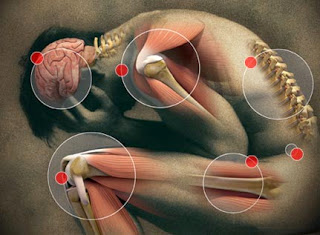What Is Chronic Pain?

Chronic pain is pain that does not go away
When pain lasts over a period of six months, or beyond the usual time for recovery , it is said to be chronic. There are different types of chronic pain, many of which are not clearly understood. Chronic pain may be associated with an illness or disability, such as cancer, arthritis or phantom limb pain. Some types of chronic pain start after an accident. Others may start as acute episodes but then the pain becomes constant over time, such as low back pain. With some types of chronic pain, like migraine headaches, the pain is recurrent, rather than constant. There are many other kinds of chronic pain, such as chronic postsurgical pain, fibromyalgia, temporo-mandibular disorders, etc. While in some cases the cause of pain is known, in many other cases it is not clear why pain persists (Canadian Psychological Association).
When pain lasts over a period of six months, or beyond the usual time for recovery , it is said to be chronic. There are different types of chronic pain, many of which are not clearly understood. Chronic pain may be associated with an illness or disability, such as cancer, arthritis or phantom limb pain. Some types of chronic pain start after an accident. Others may start as acute episodes but then the pain becomes constant over time, such as low back pain. With some types of chronic pain, like migraine headaches, the pain is recurrent, rather than constant. There are many other kinds of chronic pain, such as chronic postsurgical pain, fibromyalgia, temporo-mandibular disorders, etc. While in some cases the cause of pain is known, in many other cases it is not clear why pain persists (Canadian Psychological Association).
What Causes Chronic Pain?
There are many causes
Diseases such as shingles, cancer or diabetes, injuries or accidents and many other illnesses and conditions such as:
Long term severe chronic pain can be treated with many different medications. For information on Metadol (Methadone) and how it is used to treat severe pain click here or go to canada.com
Diseases such as shingles, cancer or diabetes, injuries or accidents and many other illnesses and conditions such as:
- Myofascial Pain ( MFP ) can be directly translated as the pain of muscle and tendons.
- Fibromyalgia Pain is pain which affects the muscles but its causes are unknown. It is a complex disease which is becoming more and more prevalent in our population. For information on fibromyalgia view here.
- Neuropathic Pain (NeP) is caused by lesions in the nervous system. Underlying causes include infections, trauma, metabolic abnormalities, illnesses such as diabetes, cancer, chemotherapy, surgery, certain medications and inherited medical conditions. For information on, diabetic peripheral neuropathy go to www.foothealthfacts.org
- Post Herpetic Neuralgia (PHN) is neuropathic pain resulting from the shingles virus and can be long lasting. For more facts on this debilitating disease and immunization go to www.Zostavax.ca
- Chronic Migraine can be the result of a patient experiencing 15 or more days each month with a headache lasting 4 or more hours each day. For more facts on the treatment of migraines or to keep a diary of your headaches go to www.BOTOX.ca and enter the drug identification number (DIN) 01981501.
- Arthritis exists in many different forms, eg: Osteo, rheumatoid, etc. The arthritis foundation offers an abundance of information on various types of arthritis as well as its symptoms at Visit www.arthritis.org For more information on medication treatment of Osteoarthritis and Rheumatoid arthritis go to www.celebrex.com
Long term severe chronic pain can be treated with many different medications. For information on Metadol (Methadone) and how it is used to treat severe pain click here or go to canada.com



